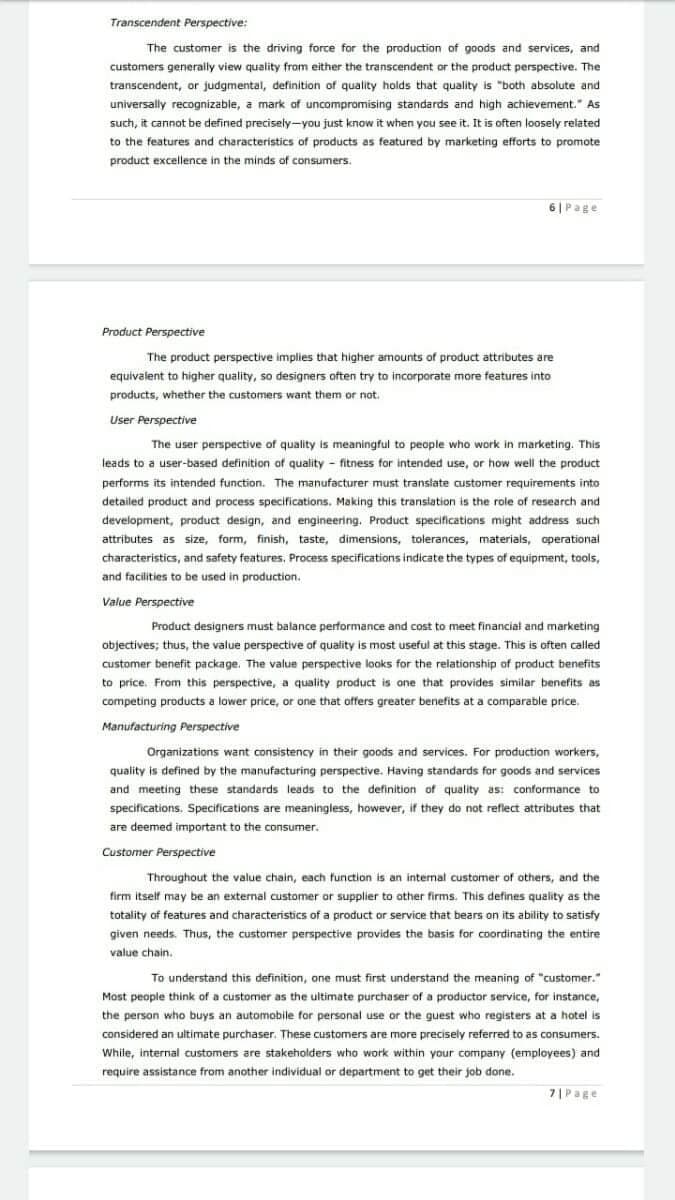1. What factors have contributed to the increased awareness of quality in modern business? 2. Explain the six quality perspectives described in this chapter. 3. Think of a product or service that you are considering purchasing. Develop a list of fitness- for-use criteria that are meaningful to you. 4. Discuss competitive advantage in this modern business. 5. What role has the Internet played in improving service quality? What barriers to service quality might it have?
1. What factors have contributed to the increased awareness of quality in modern business? 2. Explain the six quality perspectives described in this chapter. 3. Think of a product or service that you are considering purchasing. Develop a list of fitness- for-use criteria that are meaningful to you. 4. Discuss competitive advantage in this modern business. 5. What role has the Internet played in improving service quality? What barriers to service quality might it have?
Chapter13: Services Marketing
Section: Chapter Questions
Problem 5DYMP
Related questions
Question
Please help ??

Transcribed Image Text:1. What factors have contributed to the increased awareness of quality in modern business?
2. Explain the six quality perspectives described in this chapter.
3. Think of a product or service that you are considering purchasing. Develop a list of fitness-
for-use criteria that are meaningful to you.
4. Discuss competitive advantage in this modern business.
5. What role has the Internet played in improving service quality? What barriers to service
quality might it have?

Transcribed Image Text:Transcendent Perspective:
The customer is the driving force for the production of goods and services, and
customers generally view quality from either the transcendent or the product perspective. The
transcendent, or judgmental, definition of quality holds that quality is "both absolute and
universally recognizable, a mark of uncompromising standards and high achievement." As
such, it cannot be defined precisely-you just know it when you see it. It is often loosely related
to the features and characteristics of products as featured by marketing efforts to promote
product excellence in the minds of consumers.
6|Page
Product Perspective
The product perspective implies that higher amounts of product attributes are
equivalent to higher quality, so designers often try to incorporate more features into
products, whether the customers want them or not.
User Perspective
The user perspective of quality is meaningful to people who work in marketing. This
leads to a user-based definition of quality - fitness for intended use, or how well the product
performs its intended function. The manufacturer must translate customer requirements into
detailed product and process specifications. Making this translation is the role of research and
development, product design, and engineering. Product specifications might address such
attributes as size, form, finish, taste, dimensions, tolerances, materials, operational
characteristics, and safety features, Process specifications indicate the types of equipment, tools,
and facilities to be used in production.
Value Perspective
Product designers must balance performance and cost to meet financiał and marketing
objectives; thus, the value perspective of quality is most useful at this stage. This is often called
customer benefit package. The value perspective looks for the relationship of product benefits
to price. From this perspective, a quality product is one that provides similar benefits as
competing products a lower price, or one that offers greater benefits at a comparable price.
Manufacturing Perspective
Organizations want consistency in their goods and services. For production workers,
quality is defined by the manufacturing perspective. Having standards for goods and services
and meeting these standards leads to the definition of quality as: conformance to
specifications. Specifications are meaningless, however, if they do not reflect attributes that
are deemed important to the consumer.
Customer Perspective
Throughout the value chain, each function is an internal customer of others, and the
firm itself may be an external customer or supplier to other firms. This defines quality as the
totality of features and characteristics of a product or service that bears on its ability to satisfy
given needs. Thus, the customer perspective provides the basis for coordinating the entire
value chain.
To understand this definition, ane must first understand the meaning of "customer."
Most people think of a customer as the ultimate purchaser of a productor service, for instance,
the person who buys an automobile for personal use or the guest who registers at a hotel is
considered an ultimate purchaser. These customers are more precisely referred to as consumers.
While, internal customers are stakeholders who work within your company (employees) and
require assistance from another individual or department to get their job done.
71Page
Expert Solution
This question has been solved!
Explore an expertly crafted, step-by-step solution for a thorough understanding of key concepts.
This is a popular solution!
Trending now
This is a popular solution!
Step by step
Solved in 2 steps

Knowledge Booster
Learn more about
Need a deep-dive on the concept behind this application? Look no further. Learn more about this topic, marketing and related others by exploring similar questions and additional content below.